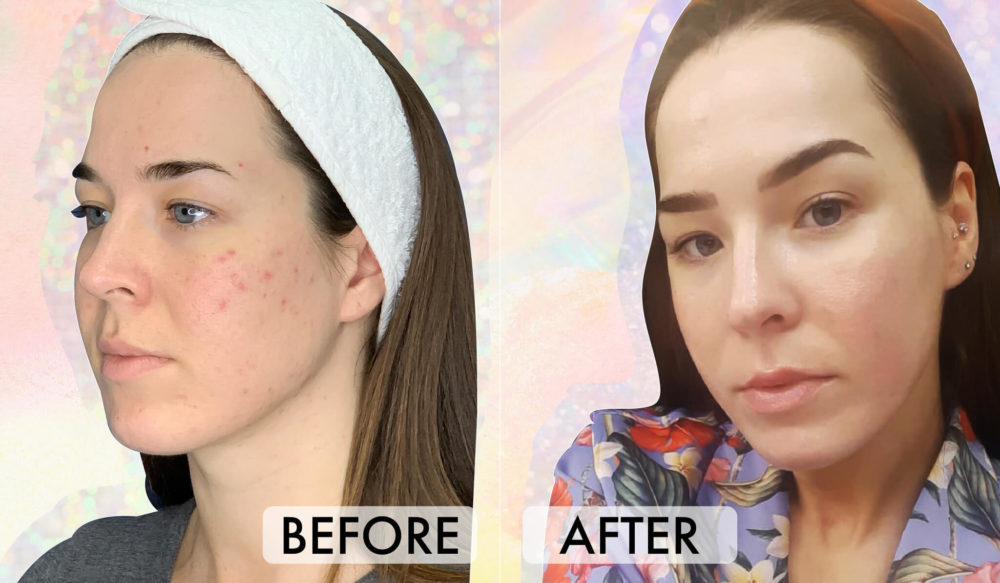The Essential Skincare Steps You Shouldn't Be Skipping... Like, Ever!
 via Giphy
via Giphy
Whenever we do an “Ask us anything” on IG, we’re constantly asked, “what products or practices will really make a difference to our skin?” And TBH, we totally get it; a 10-step routine is not always feasible – or necessary – or easy on the pocket, which means formulas that provide real results are a must. The good news is that there are some essential skincare steps that nobody should ever, ever skip – yes, even after happy hour.
To help you curate the ultimate skincare routine, we’re discussing our non-negotiable skincare steps. We’ve even added some of our current STANS so you can shop as you go. Class is officially in session.
Step #1: Double Cleansing
 via Giphy
via Giphy
Double cleansing is possibly the most important step of them all. This K-beauty technique involves washing your face twice, first with an oil-based cleanser, followed by a water-based cleanser. It should be the first step of your nighttime routine but don’t worry, it’s not necessary for the morning. (For morning, we recommend using a gentle cleanser.)
Why it’s important: You’ll be surprised at how much is left in your pores after just one round of cleansing. The first round uses a cleansing oil or balm. Oil attracts oil, so it binds with sebum, grime, and makeup most effectively – sometimes, you can even feel sebum plugs being pushed out of your pores. The second cleanse penetrates your pores more deeply and should be tailored to your skin type. For example, if you have dry skin, a rich hydrating cleanser will help cleanse and plump the skin. Alternatively, if you have oily skin, a cleanser containing enzymes, or AHAs or BHAs will help clarify the skin and really get to work on your pores..Check out our cleansing guide here for more deets.
How to do it: Massage a cleansing oil or balm, like our WISHFUL Clean Genie Cleansing Butter, $35, or Banila Co’s Clean It Zero 3-in-1 Cleansing Balm, $19, onto your skin. The buttery texture will gently wipe any traces of makeup, dirt, or dead skin debris without stripping your skin of its moisture. Follow with a water-based cleanser like Neutrogena’s Hydro Boost Hydrating Hyaluronic Acid Cleansing Gel, $8, to remove any remaining impurities – check out which cleanser works best for your skin here.
Step #2: Exfoliation
Exfoliating is one of the most integral steps in our skincare routine; from physical to chemical exfoliators, each type comes with its own rule book, which dictates how to use it and how often.
Why it’s important: Exfoliating helps remove surface dead skin cells and detox pores to leave you with an instantly brighter, more even-toned, and smooth complexion.
A “chemical exfoliator” sounds intimidating, but it’s just an enzyme or acid-based formula that penetrates deep into your pores, dislodging and dissolving dead skin cells while simultaneously promoting skin regeneration. Mechanical or physical exfoliators utilize small particles that buff away dead skin cells and dirt. Once again, there are multiple forms of physical exfoliators, some gentler than others.
While exfoliation is essential, don’t assume the more you exfoliate, the better your skin will be, as you’ll likely over-exfoliate. Over-exfoliating can weaken your skin’s protective barrier, leaving it more susceptible to bacteria, infection, and even sun damage. Go easy on the number of times you exfoliate and BE gentle with your scrubbing – remember, we’re NOT trying to be Cassie here. Limit exfoliation to two to three times per week, after you’ve cleansed and before you apply your next steps.
 via Giphy
via Giphy
Our go-to exfoliator is the WISHFUL Yo Glow Enzyme Scrub, $39. The gentle blend of AHA and BHAs, along with pineapple and papaya enzymes, make it perfect for use three to four times a week. The Pixie by Petra Glow Tonic, $15, is another cult fave chemical exfoliator – it’s formulated with glycolic acid and combined with energizing ginseng and soothing aloe vera to purify and detox the skin.
Posts You'll Love:
Step #3: Moisturizer
 via Giphy
via Giphy
Look closely at the word itself: ‘moist’urizers. These formulas douse your skin with moisture – the cornerstone to healthy, happy skin – keeping it plump, soft, and supple. Without moisture, your skin’s epidermis (the outer layer) will be weakened, and your skin can become dehydrated and dry, making it more prone to skincare concerns, including dullness, sagging, and even breakouts and sun damage.
Why it’s important: What happens when you don’t water a plant? Well, it definitely doesn’t thrive! Similarly, every skin type needs moisture, including oily skin types. In fact, without daily moisture, the skin can produce even more oil to compensate for this “lack” of moisture. In short: everyone needs to moisturize.
When to use it: As with all products, it’s important to find a formula tailored to your skin’s needs (check out our guide to skin types here). We love our WISHFUL Honey Whip Peptide Moisturizer, $43, as the lightweight moisturizer is enriched with honey and skin-building peptides that leave your skin feeling soft and plump. Alternatively, we’re also a huge fan of The INKEY List’s Peptide Moisturizer, $15, which contains a dual peptide formula to soften the appearance of fine lines and wrinkles.
Top Tip: If you’re skipping a serum before your moisturizer, look for moisturizers that pack essential skin healthy ingredients, like antioxidants (niacinamide or vitamin C) and ceramides or peptides.
Step #4: Sunscreen (During Daytime)
 via Giphy
via Giphy
If we had a dime for every time a dermatologist told us to wear sunscreen, we’d be rolling in dough. The bottom line is: that the sun is of the biggest contributors to skin damage, from collagen destruction to dark spots and pigmentation. Hence, why it’s essential to amp up your line of sun defense, and that means finding a great sunscreen, applying it daily, and not forgetting to reapply.
Why it’s important: Think of sunscreen as your very own bodyguard against the sun. Sunscreen blocks harmful UVA and UVB rays from penetrating and damaging your skin. There are two types of sunscreen: mineral and chemical. Mineral sunscreens form a protective layer that sits on your skin, reflecting the sun’s UV rays like a mirror. Chemical sunscreens contain active, chemical ingredients that absorb and disperse UV rays.
View this post on Instagram
How to apply: Apply three fingers’ worth of sunscreen over your face, neck, and décolletage – be sure to choose one with a minimum of SPF 30 and a 4 or 5-star UVA rating for full protection. You can head out immediately if you’re using a mineral sunscreen like Biossance’s Squalane + Zinc Sheer Mineral Sunscreen SPF 30 PA +++, $30. But chemical sunscreens like COSRX’s Aloe Soothing Sun Cream SPF50 PA+++, $16, take roughly 20 minutes to fully activate, so it’s best to chill before you step outside. It should be the last step in your skincare routine, slotted in pre-makeup application.
Prioritize giving your skin the love she deserves – here’s how to be kinder to her.
Disclaimer: Every product we review has been independently selected and tested without bias by our editorial team. Although some brands allow affiliate links, we never take payment to review products, so we may earn a commission if you purchase a product by clicking on one of our links.























Leave a comment